PREMISE
Helping people with vision problems navigate around with Arduino
SYNOPSIS
Having to deal with sight loss or low vision is merely one of the challenges that the visually impaired are facing living their lives. Blind individuals are just like anyone else but they just can’t see (Envision, 2019)(1). The problem is that they can’t be fully aware of the environment around them (if there’s any obstacle near them or is something getting closer to them) and therefore they can’t navigate around effectively, or confident enough. Having trouble navigating around has brought individuals with complete loss of vision or partially-sighted, many social problems too. Having difficulties in navigating, they cannot efficiently function well as a member of society, not being able to perform many jobs’ requirements and tasks as effectively, find it arduous to participate and have an active role in groups and teams, feeling limited in socializing and meeting new people, and therefore becoming isolated. This research aims at helping them navigate better to be able to do things unaided, and doing things unaided provides them to be generally more competent and effective in their big or small communities. Being generally better in navigation helps the users of this product to be more confident and therefore more likely to socialize.
CONTEXT
People who are visually impaired face a lot of difficulties functioning effectively in society and having roles in their communities. There have been inventions to help them, though they’re either too expensive or come with a giant handbook just to get started with them. Therefore, my idea is to make a gadget that is accessible, affordable, light-weighted, user-friendly, and simple.
A number of visually impaired people suffer from navigation-related activities due to mishaps that discourage them from going out for social activities and having interactions with the world outside. In contrast to the outdoors, traveling inside public spaces is a different story, as many environmental cues cannot be used and have their own set of difficulties (Watthanasak Jeamwatthanachai, Mike Wald, & Gary Wills, 2019)(2). Some technologies already have come into play in helping these people to have freedom in navigation (e.g., navigation bracelets, be my eyes application). The idea behind these technologies is brilliant, however, they are either too expensive or insufficient to fulfill the independent navigation gap as additional information is required (obstacles, barriers, and accessibility). There are things to consider, like how much it costs to use that product as a solution and how less effort is needed to learn how it works.
An affordable, sufficient solution would be a simple and inexpensive module to be a part of the user’s everyday life. A product to be implemented and used along with the things they use every day: a user-friendly, light-weighted, affordable wearable product.
In other words, we can aim at making the things they use every day to be more practical, helping them navigate better and more confidently with the world around them. A new part of their everyday life, easy to use, and without the need of learning a number of new things in order to be able to use the product. Also, to think more economically, we can set the bar really low for the pricing so that people with limited budgets can also afford the product.
The product requires no particular installations, and can be attached to their clothes, shoes, or can be carried through their most used thing –like their cane. To do so, I tried to code a simple, common board to enable it to warn both the blind person and the commuters. The main advantages of these boards are fast processing and easy interface. Today, with an increasing number of people using open source software and hardware devices day after day, technology is forming a new dimension by making complicated things look easier to use and interesting, pushing most of the hard parts backstage. These open sources provide free or virtually low costs, highly reliable, and affordable technology (Leo Louis, 2016)(3).
PROJECT
To make users (the blind or people with low vision) more conscious and therefore more authoritative of their environment, a gadget made by an ARDUINO board and some sensors can help. This gadget consists of sensors that alert a blind person by beeping when they sense obstacles and it communicates it with the user with its tone and speed: the closer one gets, the faster it beeps.
The sensor measures the distance by Ultrasonic Sensor and subsequently warns the walking person in order not to hit anything and navigate better. It emits an ultrasound that travels through the air and if there is an object or obstacle on its path, it will bounce back to the module. Considering the travel time and the speed of the sound the distance can be calculated. Once the distance is measured, it signals the beeper to go off.
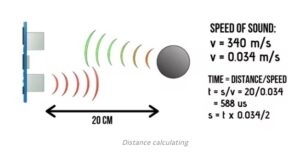

The MP3-TF-16P Player For Arduino is a small and low price MP3 module with a simplified output directly to the speaker. The module can be used as a stand alone module with attached battery, speaker and push buttons or used in combination with an Arduino UNO or any other with RX/TX capabilities.
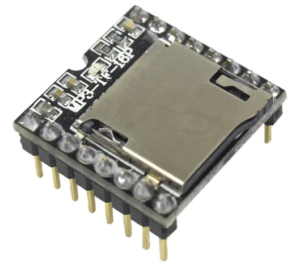
Choosing Arduino Nano is the correct answer to reach my goals; it is a cheap board with huge capabilities. It is worth mentioning that the most significant difference is that working with Arduino is so simple and understandable for any range of age and any level of being familiar with the technology. Responding to my target audience is straightforward; that was my main concern for this group of people.
I tested the functionality of the components by connecting them to the laptop and uploading test codes through Arduino IDE software to make sure they were working.
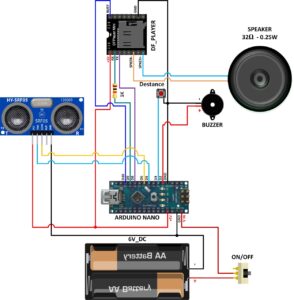
The final Circuit Diagram
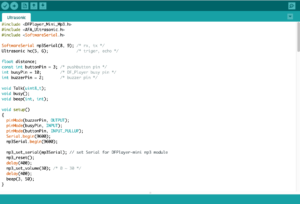
ITERATIONS 1
For the first iteration, As the main goal is to make the users (blind people and people with low vision) more aware and authoritative of their surroundings, knowing if there is an obstacle in front of them, I started by using an ARDUINO board and an Ultrasonic sensor which measures the distance. The main function of the product is to notify the user by creating voices (beeper) if there’s any obstacle around them from 5 cm to 2 meters distance. To do so, there is a buzzer implemented in the product which beeps, and as the user gets closer to the obstacle, it beeps faster.
Testing
Testing the first version, I used the help of two differently situated people, one with sight (but blindfolded) and one with the problem of having low vision just to see how effective the gadget is in order to inform the users about their environment. The reason to peak two participants with two different situations, one with no vision problem at all and the other with low vision, was mainly to provide more than one point of view into testing. As the first participant was already aware of the environment, they could give feedback about how helpful the gadget is and how it can be as helpful and informative as possible. The second participant though, as a real sample of the target audiences of the product, could give feedback about how they feel, about using the product and is it helping them effectively? They put the product in their pockets, which was the closest thing (for now) to wearing it, and performed some tasks like regular walking or walking into a new environment. We took note of all the steps to take them into consideration.
Insights
- Hearing a buzzer beep on a regular basis can be annoying, especially for people with anxiety disorders or misophonia (a disorder that decreases tolerance to specific sounds)
- Giving an alert without details of the distance of the obstacle and its direction is not the best way of communication with the user.
Results and changes
An MP3TF board was added to the product with a memory card that contains human voices to inform the user how far the obstacle is and in which direction the user is approaching it.
ITERATIONS 2
As the project goes on, I noticed that the beeping sound may not be the best way of informing the user there’s something near to them that they need to be aware of. Especially for people with anxiety or certain disorders related to hearing sounds, the beeper’s sound and the way it gets faster may be really annoying and disturbing to their daily activities. Also, a beeping sound can only communicate one simple message: that there is something around the user while there is more to communicate, like how far is it? In which direction is it located? Is it 2 meters from the right? Left? Or is it approaching the user from the back? A beeper sound surely can not communicate all this data with the user. So in this iteration, I used an MP3TF board and a memory card with some pre-recorded human voices on it to talk to the user and communicate more effectively.
Also, the information that is communicated to the user can be multidimensional. Not only does the recorded voice give the users details about their distance from the obstacle, but it can also give it in dimensions that are nearest to them. After all, instead of beeping, the message would be: “you are 2 meters from an obstacle on your left.”. This way, there is a lower risk that the voice would annoy the user, and also, the overall communication is more informative. The main advantage that adding MP3-TO brought up for me is being more connected with the environment. I see that somehow the other ability of users can be enhanced, not only for users but also for others around.
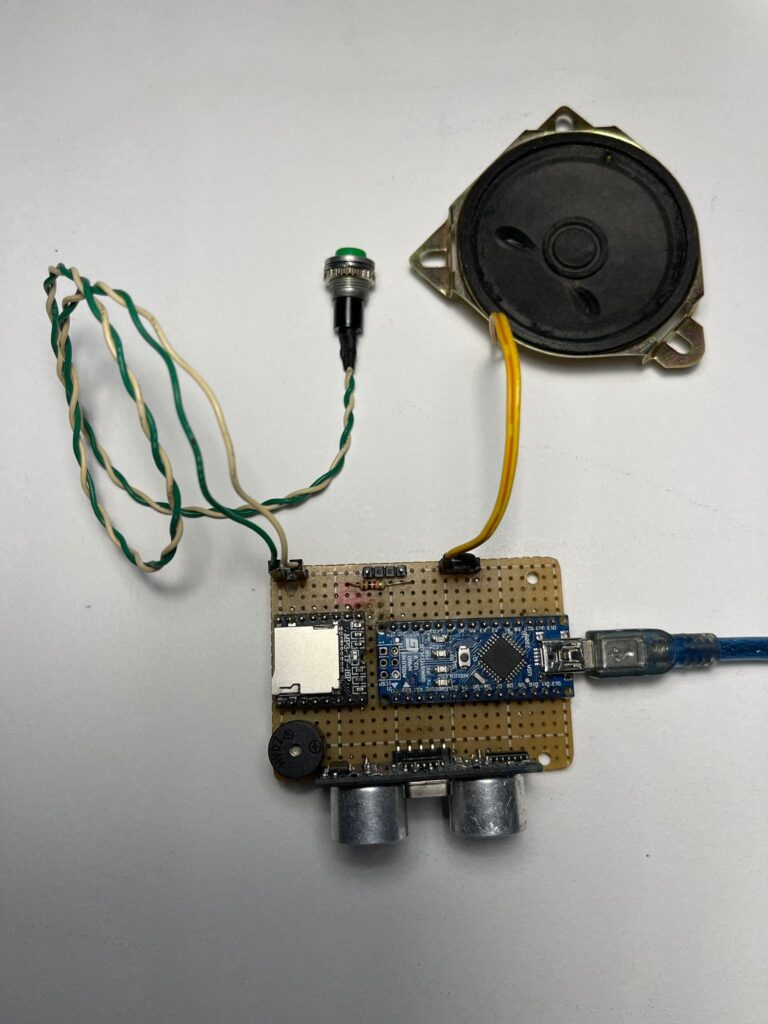
The final prototype
FUTURE STEPS AND CONCLUSION
As the next steps, we can consider making this product a sticky gadget, so the users have the freedom of choosing where to install it. It doesn’t have to go in or with anything and can be attached to their clothes, shoes, or canes. This way, we can make sure it’s totally wearable and adjustable for the user’s life. Also, the distance can be adjustable, meaning the users can define their own definition of minimum and maximum distance in order to get notified accordingly, whenever a new obstacle is around. Another thing, which potentially can be one of the future features, is to make gadgets connectable to each other, so there can be multiple gadgets reporting environmental data from different points of view to one user.
Due to the simple and cost-effective nature of the prototype, it is easy to significantly prevent accidents for the visually impaired or the blind and increase confidence. Self-help and the presence of these people in society through a simple idea of technology can not be ignored.

CITATION
[1] Envision and team, (2019). Challenges blind people face when living life.
[2] Watthanasak Jeamwatthanachai, Mike Wald, & Gary Wills, (2019). Indoor navigation by blind people: Behaviors and challenges in unfamiliar spaces and buildings. British Journal of Visual Impairment.
[3] Leo Louis, (2016). Working Principle of Arduino and Using it as a Tool for Study and Research. International Journal of Control, Automation, Communication and Systems (IJCACS)
[4] Erin Brady, Meredith Ringel Morris (2013). Visual challenges in the everyday lives of blind people. Proceedings of the SIGCHI Conference on Human Factors in Computing Systems